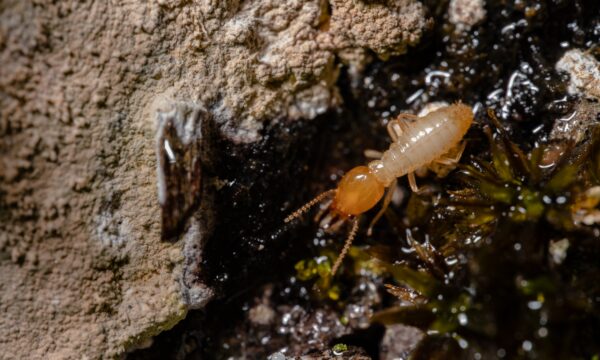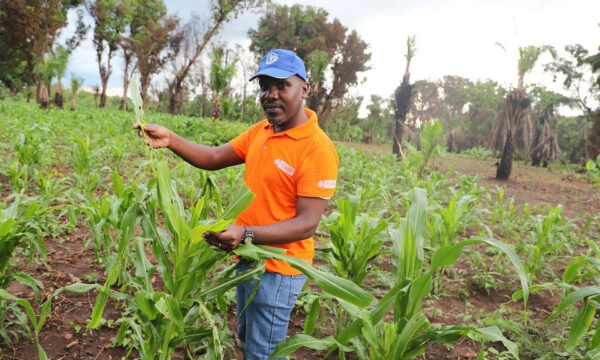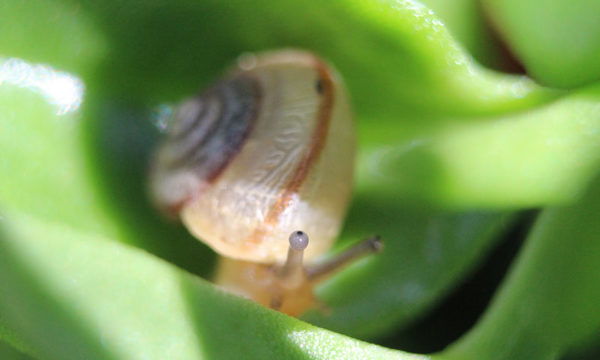
Grasshoppers are one of the leading insect pests affecting the agriculture industry across Inner Mongolia and the whole of China (© CABI)
Grassland habitats play an important ecological and economic role in Inner Mongolia, China. The primary threats to this ecosystem are grasshoppers and locusts, which are major pest insects across China. There are currently a range of monitoring and management strategies in place to control and reduce the damage caused by these pest species. However, successful reduction of these insect populations within the grassland habitats remains a national and regional challenge. Early identification of these pest species has been found to enable a more significant change of controlling the problem, with recent advances in technology opening several opportunities for developing this.
The COSMIC P&D: Pest and Disease Emergence Prediction and Control for Sustainable Agriculture project was established in 2018, with the main focus on combatting insect pest threats faced within China. The project concentrated on grasshoppers and locusts in Inner Mongolia using a multitude of new technologies to better equip the farming sector within the region to tackle future agricultural threats. The project combines the expertise of its partner organisations, including CABI, the University of Lincoln, Loughborough University and multiple Chinese partners such as IPP CAAS, the Institute of Remote Sensing and Digital Earth (RADI), and Chinese Academy of Sciences (CAS). There are three primary aims of the pest project: to refine grasshopper hatching and development models, to develop earlier detection and monitoring practices using UAV equipment, and finally to develop machine learning pest imaging technologies for use in the field.
To promote the successful establishment of these technologies, a stakeholder workshop was held in 2018 within Inner Mongolia to meet with end-users and individuals involved in agricultural research and industry within the region. This enabled the COSMIC team to fine-tune proposed developments and gain valuable insights into how best to implement these in the field.

COSMIC workshop participants, Inner Mongolia, China, 2019 (© CABI)
Earlier this month, the COSMIC team met with 20 stakeholders again in Inner Mongolia to demonstrate the outcomes of the past years’ worth of project outputs and to collect further feedback on the future development and implementation of these tools within the region to combat grasshopper and locust pest threats. Participants included academics from the Institute of Plant Protection, Chinese Academy of Agricultural Sciences, the Grassland Workstation of Inner Mongolia and Heilongjiang Province, the University of Swabi, Pakistan and senior staff from the Grassland Workstation of Xilin Gol League.
Partners from Lincoln University successfully demonstrated COSMIC’s new locust identification mobile app, which allows end-users to take an image of an area of grassland and the machine learning imaging technology built into the mobile application will automatically recognise the instar stage of the target insects captured within the image. A representative from Loughborough University provided an overview of how the use of UAV drones can be implemented into local agricultural practices under the umbrella term ‘precision agriculture’. Highlighted uses of drones within the region would allow for remote detection of locust pests in the field coupled with direct application of biopesticides and/or other chemical control tools using the drones and the image data collected. This was followed by a live demonstration of two types of drones (one for collecting spectral imaging data, the other for remote chemical spraying) by two local drone companies based in the Xilinhot area, DJI and Quanfeng, at a remote grassland site known to contain high levels of grasshopper and locust infestations.
- UAV drone demo
- Live demonstrations of COSMIC technologies in the field
- Locust identification app demo
Live demonstrations of the COSMIC project technologies, including UAV drones for insect identification and biocontrol spraying, and the newly developed locust identification app (© CABI)
To promote an open attitude towards data and knowledge sharing amongst the project partners, notably the event stakeholders from numerous agricultural research institutes within Inner Mongolia and China, representatives presented on varying topics surrounding pest management within the region, including, but not limited to, locust and crop management practices, grassland ecosystems within Inner Mongolia.
All participants were interested in the demonstrated project technologies, with high levels of engagement in the workshop feedback and interview sessions in which valuable local knowledge related to the successful implementation and future development were shared amongst both the COSMIC team, project partners and stakeholders. The question of how best to strategically use the technologies was also considered, given the size of the grasslands, the technological needs of users and the area that could be covered using the demonstrated tools, this was especially the case in relation to the UAV imaging and chemical application technologies.
For the successful implementation of any new tool, technology or model within an agricultural system, there is a need to consider the end-user and plan accordingly as a result of listening to concerns raised by partners and stakeholders within the target country or region. For the COSMIC technologies to be adopted by various agricultural organisations, governing bodies and most importantly, the farmers, further development is needed to target and develop identified gaps within the tools so to ensure these tools are accessible and useful for controlling grasshopper and locust pests within Inner Mongolia and potentially across China.
1 Comment
Leave a Reply
Related News & Blogs
Blended learning: enhancing higher education with CABI Academy
Blended learning, the integration of online and classroom-based teaching methods, has gained significant attention in the field of education. It offers unique opportunities for educators to enhance their teaching practices and provide students with a m…
3 August 2023








FAO is combining remote sensing, drones, rugged field tablets and micro sprayers to monitor and control the Desert Locust in the vast deserts from West Africa to India. Many of the same principles of early warning and preventive control also apply to the locusts and grasshoppers of Inner Mongolia.